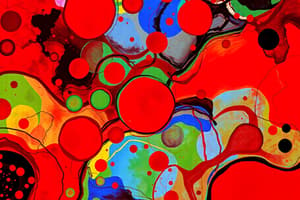Podcast
Questions and Answers
What is the primary function of blood as connective tissue?
What is the primary function of blood as connective tissue?
- To cool the body
- To transport vital substances (correct)
- To store energy
- To form muscle tissue
What percentage of blood volume in adults is approximately 5 liters?
What percentage of blood volume in adults is approximately 5 liters?
- 12%
- 20%
- 10%
- 8% (correct)
What does the hematocrit indicate?
What does the hematocrit indicate?
- Oxygen saturation level
- Blood circulation rate
- Volume of plasma in blood
- Cell concentration in blood (correct)
Which component makes up 55% of blood?
Which component makes up 55% of blood?
What are the three main types of blood cells present in the blood?
What are the three main types of blood cells present in the blood?
What is the role of white blood cells in the blood?
What is the role of white blood cells in the blood?
How is the amount of blood in the body affected?
How is the amount of blood in the body affected?
What is the primary substance that constitutes the plasma component of blood?
What is the primary substance that constitutes the plasma component of blood?
What percentage of blood is made up of plasma?
What percentage of blood is made up of plasma?
Which formed element constitutes the largest percentage of blood?
Which formed element constitutes the largest percentage of blood?
What is the main component of plasma by percentage?
What is the main component of plasma by percentage?
Which of the following white blood cells constitutes the highest percentage in blood?
Which of the following white blood cells constitutes the highest percentage in blood?
What is the function of albumins in blood plasma?
What is the function of albumins in blood plasma?
Flashcards are hidden until you start studying
Study Notes
Introduction to Blood
- Blood is classified as connective tissue.
- Functions include transporting vital substances, maintaining interstitial fluid stability, and distributing heat.
Blood Composition
- Blood constitutes about 8% of body weight.
- Adult blood volume averages around 5 liters.
- Blood is composed of 45% cells (hematocrit) and 55% plasma.
Cellular Components
- Red blood cells (RBCs) form the majority at 99% of packed cells.
- White blood cells (WBCs) and platelets make up the remaining 1%.
- Hematocrit serves as an indicator for medical conditions such as anemia and polycythemia.
Plasma Composition
- Plasma accounts for 55% of blood volume.
- Composition includes:
- Water (92%)
- Proteins (7%)
- Electrolytes, nutrients, vitamins, hormones, and waste products.
Blood Cell Types
- RBCs: Essential for oxygen transport.
- WBCs: Include five types:
- Neutrophils (54-62%)
- Eosinophils (1-3%)
- Basophils (less than 1%)
- Monocytes (2-8%)
- Lymphocytes (20-40%)
- Platelets: Cell fragments important for clotting (4.8%).
Hematocrit Measurement
- Hematocrit is the percentage of red blood cells in blood.
- Normal hematocrit values reflect overall health and can indicate various blood disorders.
Peripheral Blood Smear
- A method to visualize blood components under a microscope:
- Distinguishes between different types of blood cells.
- Assesses overall cell health and morphology.
Clinical Relevance
- Changes in blood composition can signal conditions needing medical attention:
- Lower hematocrit may suggest anemia.
- Higher hematocrit may indicate polycythemia.
Studying That Suits You
Use AI to generate personalized quizzes and flashcards to suit your learning preferences.




